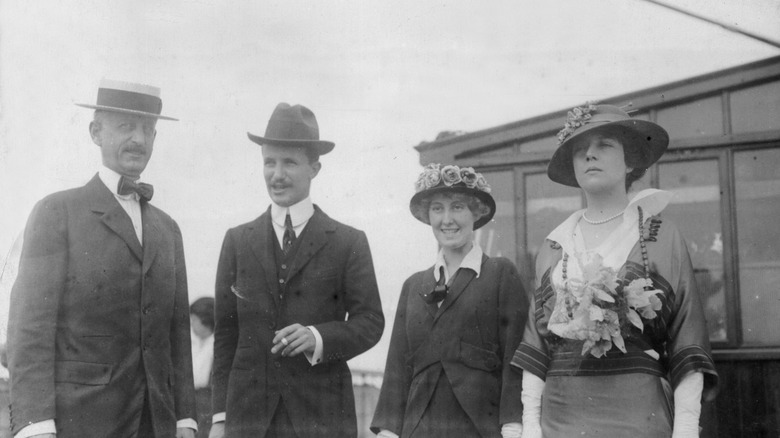The Coffee Chain Teddy Roosevelt's Kids Opened In NYC
The proliferation of coffeehouses in New York City and the 26th president of the U.S. may seem like rather disparate subjects, but there is actually quite a bit of overlap between the two.
Theodore Roosevelt was known to be a prolific consumer of coffee – and his habit actually began in childhood. Smithsonian Magazine notes that Roosevelt was known to have consumed numerous cups of strong coffee in order to mitigate his severe childhood asthma attacks. Guadalupe Roastery states that the young boy was horribly affected by the attacks, but there was minimal treatment available at the time, so his parents opted to use coffee "to strengthen his heart" and insisted that he complete rigorous physical fitness training, including boxing.
Apparently, this regimen worked out beautifully, and from then on, Roosevelt was a consistent coffee drinker. It is said that he consumed an excessive amount of coffee daily for the rest of his life. MyRecipes notes that it was once posited that he consumed about "40 cups of coffee a day!" According to Inside Sources, Roosevelt tended to consume a cup of "half-coffee, half-milk, which he immediately sweetened with a staggering seven lumps of sugar." Clearly, the drink was a mainstay throughout Roosevelt's life.
The origins of the coffeehouse started by the Roosevelt family
Coffee was undoubtedly a daily presence in the Roosevelt household, and this focus was passed on to the former president's children as well. After spending time in South America and becoming enamored with the coffee culture in the country, son Kermit Roosevelt had the idea to open coffeehouses in the U.S., according to Smithsonian Magazine. The ideal was to create a sociable, leisurely, convivial environment that celebrated discussion and premium coffee, ground and roasted in-house.
Along with his siblings Ted, Archie, and Ethel, as well as his brother-in-law and a few cousins, the group planned to open a coffeehouse in NYC with intentions "to bring quality coffee and sociable public space to harried New Yorkers." While the coffeehouses of this ilk run amok in today's landscape, this was a true rarity in that era. Smithsonian notes that coffeehouses then didn't intend on allowing patrons to "linger," but the rush-rush of NYC was a far cry from the pace of the South American model, and the Roosevelt family intended to capture that. It was also important to them to freshly ground all beans in-house, which also set them apart.
What did their coffeehouse serve?
After years of careful preparation, work, and consideration, the Roosevelts' Brazilian Coffee House was opened in New York City in November 1919. The menu consisted of food such as sandwiches, donuts, waffles, and cinnamon toast — and, in addition to coffee, the restaurant also sold orangeade royal, lemonade, ginger ale, and tea. Interestingly enough, the tables at the coffeehouse contained a "compartment furnished with ink, envelopes, and paper," and dictionaries and encyclopedias were also kept nearby.
This encouraged patrons to leisurely enjoy their coffee, perhaps get some work done, chat with a friend, indulge in a dessert, and appreciate high-quality, premium drinks. The beans were even "roasted on the premises," which was pretty unheard of at that time. Store manager A.M Salazar was a meticulous coffee fanatic who would speak with customers and employees about the proper means of preparing a good brew. He was a proponent of drinking it black, completely undiluted by any dairy products (via Smithsonian Magazine).
The later years of the Roosevelts' coffeehouse
Soon enough, prohibition did a number on the bars of New York City, but the coffeehouses were untouched, which caused a great boom in business. The Roosevelt opened more branches, named for other South American countries, i.e the location on West 44th street was called the Brazil branch, while the location on Lexington was called Argentine branch, according to Smithsonian Magazine.
Because of a name conflict and trademark issues with a nearby coffeehouse, the name of the original Brazilian Coffee House was changed to Double R Coffee House in 1921 in an ode to the Roosevelt name as well as the last name of one of the cousins (Robinson) involved in the venture, according to New York Historical Society. In the late 1920s, though, the Roosevelts' efforts and focus were elsewhere, and the coffeeshops were sold in 1928 to a pair of loyal customers. NYHS also notes that the couple had a sentimental attachment, since they had actually met there years earlier. Unfortunately, what became of the coffeehouse post-1930 is unknown — but it can be assumed that the 1929 stock market crash may have shuttered it.
From a childhood balm to an adulthood habit, coffee was a mainstay in the lives of the Roosevelt family, and their landmark 1920s cafés can unquestionably be attributed as a harbinger of today's coffeehouse culture in the U.S.



